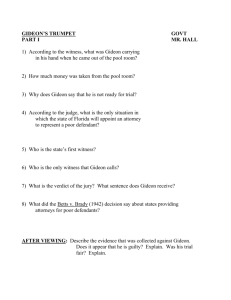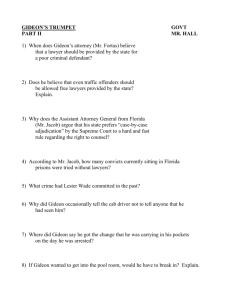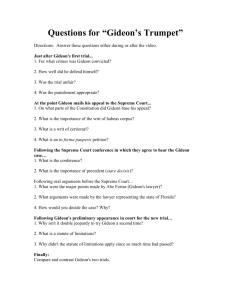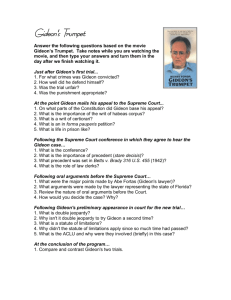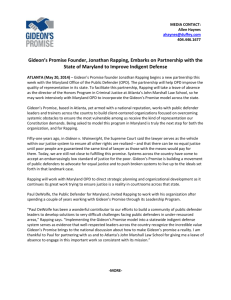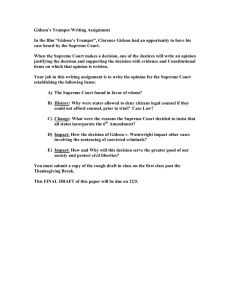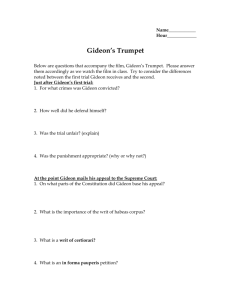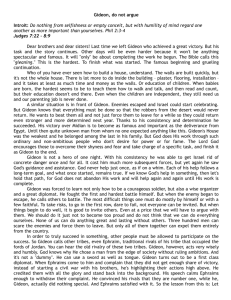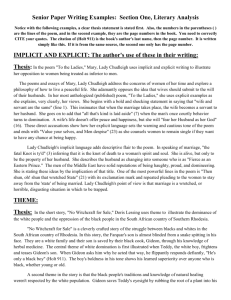Retuning Gideon's Trumpet
advertisement
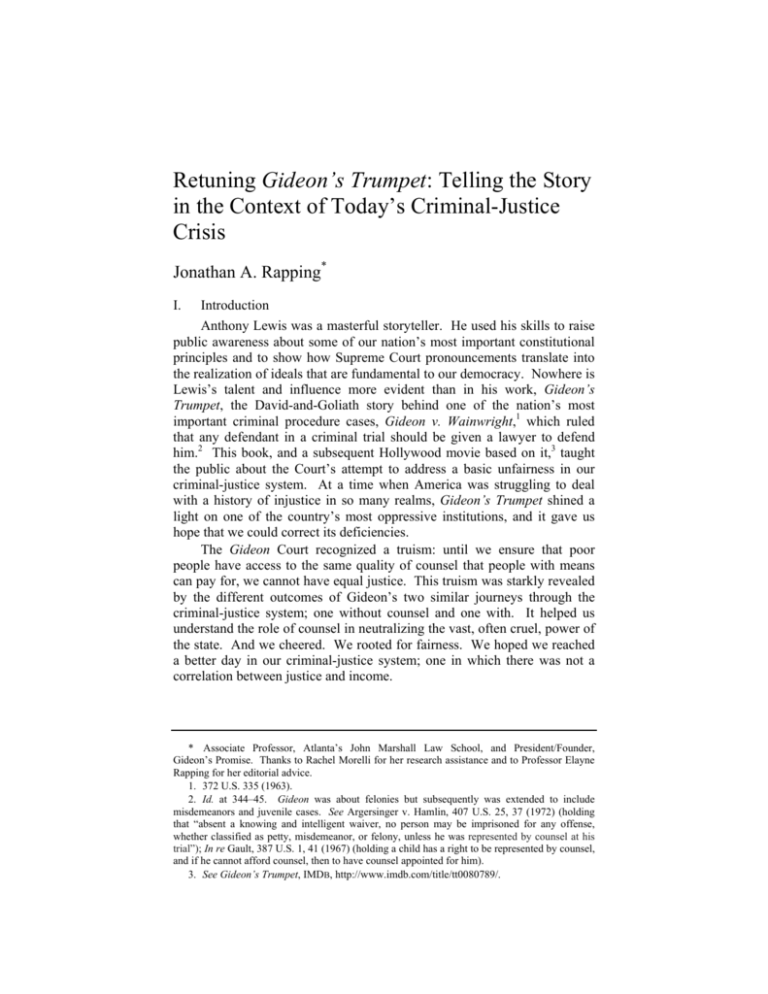
RAPPING.FINAL.OC (DO NOT DELETE) 4/19/2014 9:57 PM Retuning Gideon’s Trumpet: Telling the Story in the Context of Today’s Criminal-Justice Crisis Jonathan A. Rapping* I. Introduction Anthony Lewis was a masterful storyteller. He used his skills to raise public awareness about some of our nation’s most important constitutional principles and to show how Supreme Court pronouncements translate into the realization of ideals that are fundamental to our democracy. Nowhere is Lewis’s talent and influence more evident than in his work, Gideon’s Trumpet, the David-and-Goliath story behind one of the nation’s most important criminal procedure cases, Gideon v. Wainwright,1 which ruled that any defendant in a criminal trial should be given a lawyer to defend him.2 This book, and a subsequent Hollywood movie based on it,3 taught the public about the Court’s attempt to address a basic unfairness in our criminal-justice system. At a time when America was struggling to deal with a history of injustice in so many realms, Gideon’s Trumpet shined a light on one of the country’s most oppressive institutions, and it gave us hope that we could correct its deficiencies. The Gideon Court recognized a truism: until we ensure that poor people have access to the same quality of counsel that people with means can pay for, we cannot have equal justice. This truism was starkly revealed by the different outcomes of Gideon’s two similar journeys through the criminal-justice system; one without counsel and one with. It helped us understand the role of counsel in neutralizing the vast, often cruel, power of the state. And we cheered. We rooted for fairness. We hoped we reached a better day in our criminal-justice system; one in which there was not a correlation between justice and income. * Associate Professor, Atlanta’s John Marshall Law School, and President/Founder, Gideon’s Promise. Thanks to Rachel Morelli for her research assistance and to Professor Elayne Rapping for her editorial advice. 1. 372 U.S. 335 (1963). 2. Id. at 344–45. Gideon was about felonies but subsequently was extended to include misdemeanors and juvenile cases. See Argersinger v. Hamlin, 407 U.S. 25, 37 (1972) (holding that “absent a knowing and intelligent waiver, no person may be imprisoned for any offense, whether classified as petty, misdemeanor, or felony, unless he was represented by counsel at his trial”); In re Gault, 387 U.S. 1, 41 (1967) (holding a child has a right to be represented by counsel, and if he cannot afford counsel, then to have counsel appointed for him). 3. See Gideon’s Trumpet, IMDB, http://www.imdb.com/title/tt0080789/. RAPPING.FINAL.OC (DO NOT DELETE) 1226 4/19/2014 9:57 PM Texas Law Review [Vol. 92:1225 But fifty years later, the world Anthony Lewis inspired us to believe in has not materialized. In so many ways, our criminal-justice system is less fair, less equal, less humane. Since Gideon was decided, the U.S. imprisonment rate has nearly quadrupled,4 and the percentage of people charged with crimes who are poor has roughly doubled.5 As compared to 1963, poor people today are more likely to be arrested, convicted, and sentenced to lengthier prison terms than their wealthier counterparts. Given these depressing developments, some have questioned whether the right to counsel has made much of a difference for indigent defendants and whether it is even worth defending as a force to end the injustices of the system.6 This Essay takes a different view of the problem and argues that a strong public defender system is necessary to achieve systemic reform. This is so both because of the role the public defender plays in interrupting a process that is increasingly designed to convict and punish poor people en masse and because of the potential of a strong community of public defenders to galvanize the movement needed to push for important policy reform. There is no question that we have failed to live up to Gideon’s lofty ideals. In most of the country, the poor are given lawyers who have far too many cases to adequately handle, inadequate resources with which to do their work, and insufficient training and support.7 They are provided representation that no one with means would accept. They are thrown into the front end of our criminal-justice system and swiftly processed out the other end. Without adequate counsel to ensure all the protections necessary to achieve justice are realized, the process is a charade. To make matters worse, over the last fifty years, criminal-justice policies have become more expansive, more punitive, and more discriminatory.8 As poor people are increasingly pulled into a criminal- 4. Paul D. Butler, Essay, Poor People Lose: Gideon and the Critique of Rights, 122 YALE L.J. 2176, 2179–80 (2013). 5. Id. at 2181 (citing a Bureau of Justice Statistics report that shows the indigency rate for state felony cases was 43% in 1963 and that “[t]oday approximately 80% of people charged with crime are poor”). 6. See id. at 2178 (arguing that “Gideon has not improved the situation of accused persons, and may even have worsened their plight”); see also Gabriel J. Chin, Essay, Race and the Disappointing Right to Counsel, 122 YALE L.J. 2236, 2238 (2013) (arguing that right-to-counsel jurisprudence is unlikely to address systemic racial disparities in the system and “may have made the predicament of African Americans and other racial minorities worse”). 7. See Stephen B. Bright & Sia M. Sanneh, Essay, Fifty Years of Defiance and Resistance After Gideon v. Wainwright, 122 YALE L.J. 2150, 2152 (2013) (arguing that “overwhelming caseloads and [a] lack of resources” lead to a violation of the right to counsel every day in “thousands of courtrooms across the nation”). 8. See Jonathan A. Rapping, Who’s Guarding the Henhouse? How the American Prosecutor Came to Devour Those He Is Sworn to Protect, 51 WASHBURN L.J. 513, 537 (2012) (arguing that an increasingly expansive criminal code and harsher sentencing laws have helped shape today’s RAPPING.FINAL.OC (DO NOT DELETE) 2014] 4/19/2014 9:57 PM Retuning Gideon’s Trumpet 1227 justice system with far more draconian consequences, a robust right to counsel is more important than ever. But, given the complexities of the current situation, simply ensuring that everyone accused of a crime has a good lawyer is no longer enough. While an army of passionate, trained, and resourced defenders are fighting to ensure that those dumped into the system have adequate counsel, its soldiers must also be part of a movement that challenges the inequalities of the system. And while this movement must include a broad collection of social-justice advocates, public defenders, as the voice of the disenfranchised community from within the criminal-justice system, are critical to this effort. In this sense, Gideon becomes even more critical to realizing equal justice than anyone could have imagined when it was written, or that Gideon skeptics give it credit for. Not only does Gideon explicitly require that states provide defenders to guarantee that the people they prosecute receive equal justice in the process but also, in doing so, it demands that there be the human resources necessary to build a movement to push back against a wave of unwise criminal-justice policies that disproportionately impact the most vulnerable among us. Without such an army of defenders, the current crisis in indigent defense cannot be addressed, and Gideon’s promise cannot be realized. II. The Importance of the Right to Counsel Today While Gideon was meant to ensure that every person accused of a crime receive individualized protection, our failure to fulfill its promise has helped drive mass incarceration. To help understand this truism, think of the process that leads to mass incarceration as a swift conveyor belt, whisking people from arrest to sentencing. First, increasing numbers of people, mostly poor, are dumped onto the conveyor belt. With no friction to slow it down, the conveyor belt whisks those people to the other end. Once there, those people are dumped into prison cells, where they are held for increasingly longer periods of time. In this simplified model, mass incarceration can be understood in three stages: arrest, adjudication, and sentencing. In the first stage, because of the increasing number of behaviors defined as criminal, more and more people are subject to arrest.9 Driven largely by the War on Drugs,10 and fueled by financial and political criminal-justice system); see also Butler, supra note 4, at 2179–81 (arguing that the criminaljustice system has increasingly been used against poor people and people of color). 9. See Erik Luna, The Overcriminalization Phenomenon, 54 AM. U. L. REV. 703, 703–12 (2005) (describing how America has criminalized many previously legal behaviors in recent decades). 10. See MICHELLE ALEXANDER, THE NEW JIM CROW: MASS INCARCERATION IN THE AGE OF COLORBLINDNESS 60 (rev. ed. 2012) (calling the War on Drugs “the single most important cause of the explosion in incarceration rates in the United States”). RAPPING.FINAL.OC (DO NOT DELETE) 1228 4/19/2014 9:57 PM Texas Law Review [Vol. 92:1225 incentives to target inner city communities11 as well as biases in the criminal-justice system that disadvantage the poor,12 the number of indigent defendants accused of committing a crime grows at an alarming rate.13 Once a person is accused, our adversarial system of procedure is, ideally, designed to ensure that we do not too hastily punish a person based on an accusation. Important protections are put in place to make sure the accused actually engaged in behavior punishable by law and that the government followed rules of law consistent with American justice.14 However, our failure to provide poor people, who make up 80% of the accused,15 with lawyers who have the time, resources, and training to serve this critical role, has led to the breakdown of the adversarial process.16 Public defenders often are forced to serve as the system’s lubricant rather than in their true roles of providing the friction necessary to make sure no one reaches the other end without being afforded the required protections and making the road to sentencing less certain. In the third stage, draconian sentencing laws, which include stiffer penalties, mandatory minimums, and a slew of sentencing enhancements, ensure that the accused who reaches the end of the conveyor belt will be more likely to get a stiff sentence and be sent away for perhaps years.17 By understanding the mass incarceration process as involving these stages, the importance of a lawyer with the time, resources, and training necessary to ensure the accused is not simply processed through the system is obvious.18 But lawyers for the poor have sadly come to accept their role 11. See id. at 72–74 (discussing financial incentives to carry on the War on Drugs and target poorer communities); Rapping, supra note 8, at 529–32 (discussing political pressures to target inner-city communities). 12. See Butler, supra note 4, at 2183 (discussing bias as a stage leading to mass incarceration); Jonathan A. Rapping, Implicitly Unjust: How Defenders Can Affect Systemic Racist Assumptions, 16 N.Y.U. J. LEGIS. & PUB. POL’Y 999 (2013) (examining how implicit bias drives decisions at every stage of the criminal-justice process). 13. See Butler, supra note 4, at 2182 (demonstrating that the disparities of poor and black people in the criminal-justice system have gotten worse since the 1970s). 14. See Rapping, supra note 8, at 523–28 (discussing procedural protections and the importance of counsel in an historical context). 15. Mary Sue Backus & Paul Marcus, The Right to Counsel in Criminal Cases, A National Crisis, 57 HASTINGS L.J. 1031, 1034 (2006). 16. See David E. Patton, Essay, Federal Public Defense in an Age of Inquisition, 122 YALE L.J. 2578, 2590, 2602 (2013) (discussing how we have abandoned the adversarial process in the context of the federal criminal-justice system). 17. See Rapping, supra note 8, at 535–37 (discussing the evolution of harsher sentencing laws). 18. In concluding that providing poor people lawyers does not help to address the mass incarceration problem, Paul Butler discusses what he sees as the “five steps” of “[m]ass incarceration’s process of control.” Butler, supra note 4, at 2183–85. However, by not including a discussion of what I call the second stage, and in fact, not including any step that involves defense counsel, Butler essentially defines the role of the lawyer out of the process, ensuring his conclusion that lawyers do not matter. See id. RAPPING.FINAL.OC (DO NOT DELETE) 2014] 4/19/2014 9:57 PM Retuning Gideon’s Trumpet 1229 as helping to move cases rather than representing people.19 Stories like Robert Surrency’s are all too common.20 Surrency held the contract to represent indigent defendants in Green County, Georgia for fourteen years.21 As a part-time public defender, he would represent close to 400 clients a year, ushering more than 99% into pleas.22 He began his public defender career as a young lawyer23 and quickly adapted to the expected standards of practice. The judges demanded that he process his cases quickly, and he obliged.24 Some days he would plead dozens of clients in a single court session with little effort to negotiate on their behalf.25 More concerned with catering to systemic demands to move cases quickly and cheaply than engaging in an adversarial process, Surrency did not request investigative or expert services.26 Over time, Surrency came to see his high-volume, plea bargain practice as “a uniquely productive way to do business.”27 Unfortunately, representation for the poor more frequently looks like Green County than the constitutionally required world Gideon envisioned. Recently, two law students working for the Southern Center for Human Rights received a startling lesson about the gap between the ideals laid out in Gideon and the right to counsel in practice.28 They spent a day court watching in Butts County, Georgia. The public defender, who happened to be the chief public defender of the Towaliga Judicial Circuit, which includes Butts, Lamar, and Monroe Counties, sat silent as twenty of her clients, primarily brought in for bond determinations and probation revocation hearings, had their day in court.29 During these hearings, each with the accused’s liberty on the line, the public defender sat silent as the defendant tried unsuccessfully to advocate for himself or herself.30 Unreasonably high bonds were set and terms of probation revoked without 19. See Jonathan A. Rapping, You Can’t Build on Shaky Ground: Laying the Foundation for Indigent Defense Reform Through Values-Based Recruitment, Training, and Mentoring, 3 HARV. L. & POL’Y REV. 161, 164–65 (2009) (suggesting that too often, public defenders have adapted to a culture that is hostile to the fundamental principles of representing indigents accused of crimes). 20. AMY BACH, ORDINARY INJUSTICE: HOW AMERICA HOLDS COURT 12–28 (2009). 21. Id. at 12–13. 22. See id. at 13–14. 23. See id. at 12–13. 24. Id. at 13. 25. Id. at 14. 26. Id. at 15. 27. Id. at 13. 28. See Memorandum of Laura Bixby, Student, Stanford Law Sch., and Joshua Levin, Student, Yale Law Sch. (June 20, 2013) (on file with author). 29. See id. at 1. In fact, the complete lack of representation caused the students to initially assume these clients were pro se until it was made clear that they were represented by the public defender. Id. 30. Id. at 1–2. RAPPING.FINAL.OC (DO NOT DELETE) 1230 4/19/2014 9:57 PM Texas Law Review [Vol. 92:1225 the public defender even rising from her seat.31 In one case, a client sobbed uncontrollably as she attempted to plead her case as her lawyer looked on in silence.32 After the judge revoked her probation, and she was led away in tears, the public defender joined the court personnel in chuckling over the client’s emotional reaction.33 It was the first indication that the defender was even paying attention to anything unfolding before her. Talking to the students afterwards, the public defender talked about her clients with disdain, accusing them of being “manipulat[ive]” and trying to “beat the system.”34 Given that she hadn’t taken the time to talk to any of them to find out if they had a valid defense, the remarks were clearly indicative of a lawyer who had long ago given up on being the accused’s champion as Gideon envisioned. A budget hearing before the Tennessee legislature last year illustrates how this breakdown of the adversarial process resulting from poor lawyering has systemic impact.35 Members of the Tennessee District Public Defenders Conference were invited to testify before the Committee on Finance, Ways, and Means.36 Among the presenters were the conference president, elected to represent the public defenders statewide, and its executive director.37 The president, who is also the district public defender for the Twenty-Fourth Judicial District of Tennessee38 and one of thirty-one district public defenders in the state, was asked to discuss his view of public defender resources. Focusing on his own district, he responded as follows: You all probably could get up here and you’re always asking for more and more; but in my district, . . . I think I have enough assistants to cover the caseload that I have. I have a five county district. I have an attorney for each county. What I have done is converted one of my investigators into an attorney position so I could cover all the courts. And uh, then I have one investigator for my five county district. And our caseload, we do about four thousand cases a year. I have been blessed with retention of my staff which means I have experienced attorneys, which really helps a lot in being able to process cases. . . . They get good quality representation. Of course 31. See id. at 1–2, 4. 32. Id. at 3. 33. Id. 34. Id. at 5. 35. See Budget Hearings Before the H. Comm. on Fin., Ways & Means, 108th Leg., 1st Sess. (Tenn. 2013) [hereinafter Budget Hearings], available at http://tnga.granicus.com/MediaPlayer .php?view_id=217&clip_id=6951. 36. Id. at 35:29–1:17:28. 37. Id. at 35:30 (statement of Jeff Henry, Executive Director, Tennessee District Public Defender’s Conference). 38. Id. at 35:55. RAPPING.FINAL.OC (DO NOT DELETE) 2014] 4/19/2014 9:57 PM Retuning Gideon’s Trumpet 1231 I’m, I’m bragging I guess, I’m biased. For one district in the state . . . , I think you have supplied what I need. . . .39 The sheer volume of cases that the conference president’s lawyers handle—eight hundred per year each—and his attitude about the acceptability of this caseload suggest a district in which every client likely gets the representation described in the anecdotes above. That the elected representative of the conference of chief defenders in Tennessee, while accompanied by the executive director, could make these remarks to a committee that controls the state budget is further evidence that this lack of adversarialism is accepted systemically. Anthony Lewis might well weep to see what has become of the high ideals of the case he so vividly narrated. It seems obvious that one cannot tell the story of mass incarceration without including the stage during which cases are shepherded from arrest to sentencing.40 This processing, which plays out on a grand scale in courtrooms across the country daily, could not happen without the complicity of many public defenders, most of whom are well-intentioned but have had their expectations shaped by the systems in which they work.41 It is the primary reason the accused can be so efficiently whisked through the process without any resistance. Our failure to provide poor people the representation the Gideon Court envisioned is largely responsible for our criminal-justice crisis. But in a system that is driven by unjust criminaljustice policies that are beyond the influence of the trial process, ensuring that every person has a good lawyer will not be enough to realize equal justice. The right to counsel must be part of a larger solution that includes policy reform. But policy reform cannot occur without an army of advocates doing the necessary legwork on the ground. And a strong public defender voice is critical to driving this effort. Although not its direct objective, in this sense Gideon, which mandated that each defendant be given a lawyer, becomes the vehicle through which we can fuel the movement that will be necessary to transform criminal justice. The skeptic, 39. Id. at 44:15 (emphasis added). 40. A report by the Justice Policy Institute entitled System Overload: The Costs of UnderResourcing Public Defense illustrates how a strong public defender presence from arrest through sentencing addresses systemic injustice. It points to five specific ways that poor lawyering can drive incarceration: “1. more pretrial detention for people who do not need it; 2. increased pressure to plead guilty; 3. wrongful convictions and other errors; 4. excessive and inappropriate sentences . . . ; and 5. increased barriers to successful re-entry into the community.” JUSTICE POLICY INST., SYSTEM OVERLOAD: THE COSTS OF UNDER-RESOURCING PUBLIC DEFENSE 18 (2011), available at http://www.justicepolicy.org/uploads/justicepolicy/documents/system_ overload_final.pdf. 41. With few exceptions, even the most heroic public defenders will eventually have to adapt to the system or leave the profession as crushing caseloads, lacking resources, and systemic pressures to process clients wear down even the best. For a discussion about how idealistic public defenders are forced to redefine their roles in broken systems, see Jonathan Rapping, Redefining Success as a Public Defender: A Rallying Cry for Those Most Committed to Gideon’s Promise, CHAMPION, June 2012, at 30. RAPPING.FINAL.OC (DO NOT DELETE) 1232 4/19/2014 9:57 PM Texas Law Review [Vol. 92:1225 who only views the benefits of Gideon through the lens of individual representation, misses the systemic value of the role public defenders play beyond the courtroom. III. The Broader Role of the Public Defender Fully aware of what I have described above, when I first read Paul Butler’s argument that “Gideon has not improved the situation of accused persons, and may even have worsened their plight,”42 I was mystified by his position. It is similar to the view of George Bailey in the Frank Capra holiday classic, It’s a Wonderful Life.43 George spent his adult life fighting to help the working class people of Bedford Falls against a wealthy tyrant (Mr. Potter) who otherwise controlled the town. Potter hoped to control the entire town, and George was the only thing standing in his way. Potter surely heaped a significant amount of injustice on the townspeople, but the only thing that mitigated the total takeover by Potter was George’s commitment to a Savings and Loan that kept many townspeople just out of Potter’s reach. When George’s fortunes hit a low and he begins to think he has not made a difference to the town and that the world would be better off without him, his guardian angel helps him see how much worse things would have been had he never existed. By allowing George to see Bedford Falls without his contributions, the angel helps him understand the value of his contribution to the world. The analogy is apt, because Professor Butler asks us to view the worsened plight of the poor in the criminal-justice system and conclude that, because they are arguably worse off than they were in 1963, Gideon’s presence has not made a difference.44 In Butler’s story, increasingly inhumane criminal-justice policies substitute for Potter, the poor accused of crimes take the place of the townspeople of Bedford Falls, and Gideon plays the role of George Bailey. When times are especially bleak for indigent defendants, it is tempting to conclude that Gideon has not made a difference, particularly when one does not consider what the plight of the poor would be like without it. But, as discussed above, in much of the country, Gideon has never been realized. And so we are privy to a view of a criminal-justice system without Gideon lawyers to fight for the poor in the vein of George Bailey. 42. Butler, supra note 4, at 2178. 43. See It’s a Wonderful Life, IMDB, http://www.imdb.com/title/tt0038650/. This fitting analogy was brought to my attention by Dawn Deaner, the public defender for the City of Nashville and Davidson County (Nashville, TN), after discussing this argument with several public defender leaders with whom I work. 44. See Butler, supra note 4, at 2178. RAPPING.FINAL.OC (DO NOT DELETE) 2014] 4/19/2014 9:57 PM Retuning Gideon’s Trumpet 1233 We see this Gideon-less world in numerous counties across the country.45 It may be that poor defendants in some of these places are better off than they would have been in 1963, just as it may be that the working poor of Bedford Falls may have been better off fifty years before either Mr. Potter or George Bailey were around. But that is not the relevant question. The question should be whether poor defendants in our nation’s broken systems would be better off with a well-resourced, committed, zealous attorney or without anyone who cared about their plight in their corner. There are countless tragic stories of people forced to rely on poor lawyers, who desperately wish they had a real advocate, that answer this question. But to truly understand a world without public defenders and the cost to equal justice, we must look beyond the myriad examples of people processed through the system without representation and consider the role public defender leaders play outside the courtroom. Just as stories of bad lawyers allow us to see the individual cost of not fulfilling Gideon’s promise, examples of ineffective public defender leaders illustrate the systemic cost. They do so by showing what a world without that leadership will look like and the ripple effect of its absence. It is a world where processing is enabled by people viewed as experts. The president of the Tennessee District Public Defender Conference was able to position himself to be a voice at a legislative hearing, the fulcrum of where policy decisions are made. He was provided the opportunity to educate the presiding committee about what is happening in the criminal-justice system. Rather than sound the alarm on which his hand rested, he told the committee all is fine. His leadership, or lack thereof, virtually ensured that four thousand people a year will continue to be processed through the criminal-justice system in his district.46 But the impact is far more extensive. He set a terribly low bar for every poor person in the state. He ensured that no conscientious defender could effectively advocate for justice. Consider what happens when a more 45. This phenomenon has been documented in countless articles over the years and during this fiftieth anniversary of Gideon. For examples, see generally Stephen B. Bright, Essay, Counsel for the Poor: The Death Sentence Not for the Worst Crime but for the Worst Lawyer, 103 YALE L.J. 1835 (1994); Bright & Sanneh, supra note 7, at 2160–71; David Cole, Gideon v. Wainwright and Strickland v. Washington: Broken Promises, in CRIMINAL PROCEDURE STORIES 101 (Carol S. Steiker ed., 2006); Rapping, supra note 19, at 164–73. 46. In this defender’s district, each lawyer is expected to process eight hundred cases per year. See Budget Hearings, supra note 35, at 44:40 (noting that his office contains 5 lawyers handling 4,000 cases per year). Assuming defenders work sixty-hour workweeks and take two weeks a year for vacation, without any other sick leave or family time, each client receives roughly three hours and forty-five minutes of representation per year. When one considers all that goes into providing effective representation—client communication, investigation, discovery, conducting and litigating case-specific legal issues, court time, plea negotiations, etc.—it becomes obvious that this effective absence of counsel renders the process perfunctory. RAPPING.FINAL.OC (DO NOT DELETE) 1234 4/19/2014 9:57 PM Texas Law Review [Vol. 92:1225 thoughtful defender complains that poor people in his district are not getting adequate representation because each of his lawyers has four hundred cases per year—half of what the president’s defenders handle but still far too many to represent effectively. Based on this testimony, the response may very well be, “Suck it up, they should be able to handle twice that number; just ask your conference president.” If this leader were so inclined, he could have helped the committee understand that public defense is broken in his district and statewide. He could rally members of the conference to collectively begin to educate stakeholders about the crisis and the very real costs, both in terms of economics and justice. He could lead the charge to reform broken aspects of the system, positively impacting the quality of justice for thousands of people a year in his district and hundreds of thousands per year statewide. This is a role that good public defender leaders play in our criminal-justice system. A look at New Orleans illustrates this point well, as it is a rare example of a city that went from having one of the nation’s most dysfunctional public defender offices to boasting of an office that is committed to trying to live up to the Gideon ideal. Hurricane Katrina provided an opportunity to rebuild New Orleans’s public defender system, giving observers an opportunity to see if good public defenders make a difference in unjust systems.47 Pre-Katrina criminal justice in New Orleans was marked by structural deficiencies that drove the office and its lawyers to be beholden to the judges rather than their clients.48 As part-time public defenders with private caseloads, these lawyers had little interest or incentive to spend any time with their clients beyond routine court proceedings.49 With public defenders not appointed unless and until the prosecution decided to formally charge the accused, a process that took a minimum of forty-five days for a misdemeanor and sixty days for a felony,50 the defendant who could not afford to hire a lawyer would sit in jail during this time without access to counsel,51 thus preventing him or her from resolving even the simplest case before his or her life was tragically disrupted. 47. This author was part of the management team that set out to rebuild Orleans Public Defenders in 2006. This experience is detailed in Jonathan A. Rapping, Directing the Winds of Change: Using Organizational Culture to Reform Indigent Defense, 9 LOY. J. PUB. INT. L. 177 (2008). 48. Id. at 186–88. 49. Id. at 189. 50. Id. at 188 (citing to the original report, NICHOLAS L. CHIARKIS ET AL., AN ASSESSMENT OF THE INTERMEDIATE AND LONGER-TERM NEEDS OF THE NEW ORLEANS PUBLIC DEFENDER SYSTEM 7 (2006), available at http://jpo.wrlc.org/bitstream/handle/11204/119/2359.pdf? sequence=1). 51. Id. In a recently published article, I provide the following account of my first experience in a New Orleans courtroom in October 2006: RAPPING.FINAL.OC (DO NOT DELETE) 2014] 4/19/2014 9:57 PM Retuning Gideon’s Trumpet 1235 Katrina brought with it an opportunity to rebuild. A new management team fought intense battles to force reform in the system, eventually forging a full-time public defender office with well-trained, committed defenders, an investigative staff, and standards.52 Against harsh opposition from the judges, this leadership team implemented a vertical system of representation where clients keep the same lawyer throughout the life of the case rather than being tethered to a judge, one of the American Bar Association’s ten principles of effective indigent defense delivery systems that shifts control from the court to the client.53 Defender-driven reforms have not only allowed tens of thousands of clients to be appointed defenders committed to interrupting a system designed to otherwise ensure their incarceration, rather than lawyers who are resigned to processing them through that system, but they have also completely changed the landscape of indigent defense. For example, prior to Hurricane Katrina, the Orleans Parish Jail population exceeded 6,500 people per day.54 Today that figure is closer to 2,000 and falling.55 This shift is directly the result of public defender I walked into a courtroom in Orleans Parish District Court for the first time. The scene was fairly chaotic. People, primarily men, in suits wandered about the well of the court chatting to one another. I assumed they were attorneys, although one could not discern the defenders from the prosecutors. The only players who could be readily identified were the judge, who sat on the bench in a robe, and the prisoners, who were lined up in a row, wearing orange jumpsuits, off to the left side of the courtroom. The suited men had no contact with the defendants. It was not clear that any of the lawyers had ever met any of the defendants before. When a case was called, one of the suited men would speak for the man whose name was connected to the case. However, none of the men in jumpsuits would be brought to his spokesman’s side, and the lawyer often barely acknowledged his client. Then, the judge called a case with no suited spokesman. When it was clear that there was no lawyer claiming this particular client, the judge turned to the row of men in orange and asked the one whose case it was to stand. One of the prisoners rose. “Where is your lawyer?” asked the judge. “I haven’t seen a lawyer since I got locked up,” the man replied. “How long has that been?” asked the judge. “Seventy days,” said the man, seemingly resigned to the treatment afforded him. “Have a seat,” was the judge’s response as he moved on to the next case. Johnathan A. Rapping, National Crisis, National Neglect: Realizing Justice Through Transformative Change, 13 U. PA. J.L. & SOC. CHANGE 331, 349 (2009–2010). 52. Rapping, supra note 47, at 194–95, 220. 53. Id. at 194–95; see also AM. BAR ASS’N, TEN PRINCIPLES OF A PUBLIC DEFENSE DELIVERY SYSTEM 3 (2002), available at http://www.americanbar.org/content/dam/aba/ administrative/legal_aid_indigent_defendants/ls_sclaid_def_tenprinciplesbooklet.authcheckdam .pdf (setting forth Principle 7, which recommends that “the same attorney should continuously represent the client from initial assignment through the trial and sentencing”). 54. NAT’L PRISON PROJECT, AM. CIVIL LIBERTIES UNION, ABANDONED & ABUSED: ORLEANS PARISH PRISONERS IN THE WAKE OF HURRICANE KATRINA 13 (2006), available at https://www.aclu.org/files/pdfs/prison/oppreport20060809.pdf. 55. As of August 27, 2013, the number of inmates totaled 2,400. Naomi Martin, Size of New Orleans Parish Jail up to City Council, TIMES-PICAYUNE (New Orleans), Aug. 27, 2013, http://www.nola.com/crime/index.ssf/2013/08/ new_orleans_city_council_to_de.html. RAPPING.FINAL.OC (DO NOT DELETE) 1236 4/19/2014 9:57 PM Texas Law Review [Vol. 92:1225 leadership that has insisted on being at the policy table while strengthening the practice.56 First, the chief public defender successfully argued for, and worked with, the district attorney (DA)’s office to make expedited charging determinations, a top priority for the New Orleans Mayor’s Criminal Justice Leadership Alliance.57 Second, the chief public defender sat down with the DA, the sheriff, and other decision makers to come up with smart solutions to the pretrial detention problem and access to courts—successfully advocating for the implementation of independent pretrial services.58 Third, the chief public defender served on the New Orleans mayor’s criminaljustice working group, where he advocated for a smaller jail.59 Ultimately, the working group voted to limit the new jail (currently under construction) to just over 1,400 beds, which was codified by city ordinance.60 Finally, by assigning lawyers at the point of arrest, rather than the previous policy of waiting for the accused to be formally charged, lawyers at the Orleans Public Defenders Office are able to go to work within twenty-four hours of arrest, getting appropriate cases dismissed and clients released much earlier in the process.61 For anyone concerned about mass incarceration, this effort is especially noteworthy. Of the over 2.2 million people incarcerated in this 56. See History, ORLEANS PUB. DEFENDERS (June 22, 2012), http://www.opdla.org/about-usmenu/about-opd/our-history (noting that after Katrina, the public defender office was revamped by public defender leaders such as the head of the Washington, D.C., public defender service). 57. The City of New Orleans adopted a Master Plan, titled Plan for the 21st Century, which is available at http://www.nola.gov/city-planning/master-plan/. In the appendix, the mayor, chief judge, district attorney, and public-defender leaders all signed a “Statement of Commitment to Implement a Criminal Justice Reform Agenda for New Orleans,” which lays out several principles of reform, including making expedited charging determinations so that people would spend less time sitting in jail waiting to be charged with a crime. For that Statement, visit http://www.nola.gov/getattachment/ae42e6b4-6ef8-4411-8957-1e5b8ca48bee/Appendix-Ch-8Criminal-Justice-Reform-Statement-of/. 58. See David Carroll, Gideon Alert: New Orleans DA Questions Appointed Counsel for Those Who Make Bail, JSERI BLOG, NAT’L LEGAL AID & DEFENDER ASS’N (Nov. 9, 2011, 9:48 AM), http://www.nlada.net/jseri/blog/gideon-alert-new-orleans-da-questions-appointedcounsel-those-who-make-bail (noting that “the district attorney and public defender agreed that a pre-trial services program would improve the situation by providing independent screening of defendants” (internal quotation marks omitted)). 59. See Katy Reckdahl, Task Force Continues Debate over Proper Size for New Orleans Jail, TIMES-PICAYUNE (New Orleans), Nov. 21, 2010, http://www.nola.com/politics/index.ssf/2010/11/ task_force_continues_debate_ov.html (reporting that Derwyn Bunton, chief public defender and a member of the mayor’s working group, advocated for a smaller jail because it “forces people to innovate”). 60. Naomi Martin, Orleans Parish Prison Reform Coalition Demands Mayor Mitch Landrieu Enforce 1,438-Bed Cap on New Jail, TIMES-PICAYUNE (New Orleans), Sept. 13, 2013, http://www.nola.com/crime/index.ssf/2013/09/orleans_parish_prison_reform_c.html. 61. See Mac McClelland, The Defense Never Rests, MOTHER JONES, Jan./Feb. 2012, at 14, 14 (interviewing Derwyn Bunton, the chief public defender, who noted the successful effort to get access to arrestees much earlier in the process). RAPPING.FINAL.OC (DO NOT DELETE) 2014] 4/19/2014 9:57 PM Retuning Gideon’s Trumpet 1237 country,62 over 20% have yet to be found guilty of a crime.63 Therefore, addressing pretrial detention is significant to any effort to address the massincarceration problem, and providing poor people effective lawyers has a significant impact on these detention rates. According to one study, adequately prepared and resourced “defense attorneys at the first appearance results in defendants being released on their own recognizance twice as often than if they were unrepresented, and . . . bail [being] reduced four times as often for the remaining defendants.”64 The study concludes that “[t]his translates into a 20 percent reduction in the average amount of time spent in jail per defendant.”65 Additionally, those released pretrial will likely experience lower incarceration rates after conviction. Another study found that “defendants who are incarcerated pretrial have worse case outcomes than defendants who are allowed to remain at liberty. . . . [They] are more likely to be convicted, if convicted they are more likely to be sentenced to incarceration, and if incarcerated their sentences are likely to be longer.”66 These findings support the importance of having a strong public defender voice advocating for systemic change and help one appreciate the significance of building a public defender office in New Orleans for criminal-justice reform. The other lesson of New Orleans is just how precarious the implementation of policy reform can be without foot soldiers on the ground to make it a reality. There were strong forces resistant to change, and absent a strong public defender office fighting to ensure the opportunity did not slip away, New Orleans would surely not have made the progress it has to date.67 There are certainly examples of promising policy reforms that 62. Adam Liptak, 1 in 100 U.S. Adults Behind Bars, New Study Says, N.Y. TIMES, Feb. 28, 2008, http://www.nytimes.com/2008/02/28/us/28cnd-prison.html?_r=0. 63. In 2008, 800,000 people were held in America’s jails. Approximately 61% of these inmates have not yet been convicted of a crime. Therefore, roughly 488,000 people, or 21.2% of all incarcerated persons, are subject to pretrial detention each year. PRETRIAL JUSTICE INST., MACARTHUR FOUND., RATIONAL AND TRANSPARENT BAIL DECISION MAKING: MOVING FROM A CASH-BASED TO A RISK-BASED PROCESS 1 (2012), available at http://www.pretrial.org/ Featured%20Resources%20Documents/Rational%20and%20Transparent%20Bail%20Decision% 20Making.pdf. 64. John P. Gross & Jerry J. Cox, The Cost of Representation Compared to the Cost of Incarceration, CHAMPION, Mar. 2013, at 22, 23 (summarizing the study mentioned). For the actual study, see Douglas L. Colbert et al., Do Attorneys Really Matter? The Empirical and Legal Case for the Right of Counsel at Bail, 23 CARDOZO L. REV. 1719 (2002). 65. Gross & Cox, supra note 64. 66. Id. (summarizing the second study). For the actual results of the second study, see MARY T. PHILLIPS, N.Y.C. CRIMINAL JUSTICE AGENCY, A DECADE OF BAIL RESEARCH IN NEW YORK CITY (2012), available at http://www.cjareports.org/reports/DecadeBailResearch.pdf. 67. Cf. Rapping, supra note 47, at 211 (offering solutions to help overcome resistance to cultural change). RAPPING.FINAL.OC (DO NOT DELETE) 1238 4/19/2014 9:57 PM Texas Law Review [Vol. 92:1225 never amounted to much without leadership on the ground to usher in actual change. This is one example—although hardly the only one I could mention— of how public defender leadership can play a role in initiating and implementing reforms that help poor people receive more justice. Among the community of public defender leaders I work with (discussed below), there are countless examples like these that collectively have a palpable impact. And while such efforts may not have been the purpose of Gideon, it is certainly the result. A strong public defender ethos committed to a humane criminal-justice system for the poor and visionary leaders to push for reform grow out of a community of public defenders who possess the “mind-set, heart-set, [and] soul-set”68 to live up to Gideon’s promise. Gideon provides the foot soldiers that can then be part of a larger, coordinated movement to realize justice. IV. Building the Movement For the past seven years, I have been working with a committed community of public defenders to build the movement necessary to drive criminal-justice reform. Aptly named Gideon’s Promise,69 this movement is based on the idea that there will never be meaningful reform until we transform a culture in our criminal-justice system that has come to accept an embarrassingly low standard of justice for poor people. This culture is driven by a set of assumptions that influence the mindset of not only those who work in the system (judges, prosecutors, police, defenders, etc.) but also policymakers and the public at large.70 This culture is reflected in the way that police, prosecutors, and judges exercise their discretion in ways that promote the current system; defenders who have come to accept their role in maintaining the status quo; policymakers who support policies that drive these outcomes; and a public that does not understand this reality. Collectively, we have abandoned those values most essential to justice. It is the mission of Gideon’s Promise to raise our national consciousness about the importance of these values and to advocate for reform consistent with them. Starting in the courts where the absence of these values causes the most damage, and spreading throughout the criminal-justice system and 68. Barbara Allen Babcock, Commentary, Defending the Guilty, 32 CLEV. ST. L. REV. 175, 175 (1983–1984). 69. The organization was originally named the Southern Public Defender Training Center. It changed its name to Gideon’s Promise in January 2013. For the philosophy behind the organization’s theory of change, see Rapping, supra note 19, at 173–80. To learn more about Gideon’s Promise, visit www.gideonspromise.org. 70. For a more comprehensive discussion of the theory behind transforming culture in the criminal-justice context, see Rapping, supra note 19, which outlines a model for defender-driven culture change, and Rapping, supra note 47, which discusses organizational culture in the context of indigent defense. RAPPING.FINAL.OC (DO NOT DELETE) 2014] 4/19/2014 9:57 PM Retuning Gideon’s Trumpet 1239 beyond, the public defenders at Gideon’s Promise are changing the way people think about the importance of the work we do and the humanity of the people we represent. Gideon’s Promise is building a movement that provides comprehensive, ongoing training and support to new public defenders learning how to provide their clients the representation they deserve, midlevel defenders transitioning into leadership roles, and public defender leaders overseeing defender organizations. What started as a partnership with two public defender offices in 2007 has blossomed into a coalition that includes over thirty-five partner offices and more than two hundred fifty defenders in the South and beyond.71 Gideon’s Promise also works with chief defenders and trainers from public defender offices across the country who are interested in exporting its model and with law students and law school faculty, nationally, to encourage graduates to join the effort to raise the standard of representation in places with the greatest need.72 In addition to building a movement of public defender advocates, the Gideon’s Promise community engages in extensive outreach and education to raise awareness of the criminal-justice crisis and to promote solutions. Gideon’s Promise continues to develop relationships with members of the faith-based community, corporate America, the broader legal community, and social-justice organizations to help them appreciate how these issues impact their interests. Our lawyers advocate in courtrooms every day. Our leaders meet with decision makers at every level of state and local government to push for reform. Members of our community participate in trainings, panels, and presentations across the country. We recently partnered with a documentary filmmaker to create Gideon’s Army, an award-winning HBO documentary that has helped raise public awareness of the criminal-justice crisis.73 Gideon’s Promise is forging an army of public defenders to bring their clients justice today and developing them into the leaders of tomorrow. A successful movement needs both foci. This is a movement forged by a community of committed public defenders. They are lawyers who refuse to accept the status quo. They are leaders who drive efforts to enact policies that make the system more humane for poor people. Although they work in systems in which Gideon has never been respected, they would not be available for this fight if it were not for Gideon first forging the way by mandating that every defendant have a lawyer. But their work goes beyond the original Gideon mandate by pushing to demand even more from the 71. While Gideon’s Promise started as an organization that worked with southern defenders, it has piloted its model in offices beyond the region and has a growth model that envisions a national presence. 72. Our Solution, GIDEON’S PROMISE, http://gideonspromise.org/our-solution/. 73. To learn more about Gideon’s Army, visit www.gideonsarmythefilm.com. RAPPING.FINAL.OC (DO NOT DELETE) 1240 4/19/2014 9:57 PM Texas Law Review [Vol. 92:1225 system than Gideon first envisioned. They represent a small example of what a world with Gideon could look like. V. Conclusion Gideon said that ensuring poor people have effective advocates when their liberty is on the line is necessary to ensure equal justice. It never said this alone was sufficient. And while the Gideon Court could not have foreseen how hostile the larger criminal-justice system would become towards poor people, it correctly understood the value of a lawyer to help the accused navigate the adjudicatory process. But for those of us committed to criminal-justice reform, we absolutely need to look beyond a narrow view of the right to counsel as a panacea. It must be coupled with advocacy beyond the courtroom to reclaim saner and more equitable criminal-justice policies. Public defenders must be part of this effort, and those of us working in the indigent defense arena need to build a public defender movement working to change the way the public views our clients, the threat to equal justice that confronts them, and the role of the public defender in realizing a fairer criminal-justice system. For skeptics of the importance of Gideon, none of this matters. They see an increasingly unjust criminal-justice system in a post-Gideon world and conclude that Gideon has made no difference. But this analysis ends with a very narrow view of the systemic benefit of Gideon: it falls short of appreciating what an army of public defenders means systemically. Therefore, this view is far too limiting for a meaningful discussion of the benefits of Gideon. We also have to examine what public defenders contribute beyond the courtroom to understand the impact of a case that serves as the engine for building a movement of public defenders. In 1963, Anthony Lewis narrated an important story about the importance of the right to counsel in ensuring the criminal process is fair. His story, and the case upon which it is based, is no less important today than it was fifty years ago. However, in light of the changing criminaljustice landscape, there is a need for a sequel. A story that helps the public understand the enormity of the challenges that lie ahead, the need for a movement to address these challenges, and the critical role the public defender must play if this effort is to succeed. Given how unlikely it is that a storyteller with Mr. Lewis’s skill and understanding of the subject matter will come along again, it will be left to this movement of advocates to tell this modern story of the importance of Gideon and what is needed to fulfill its promise.
